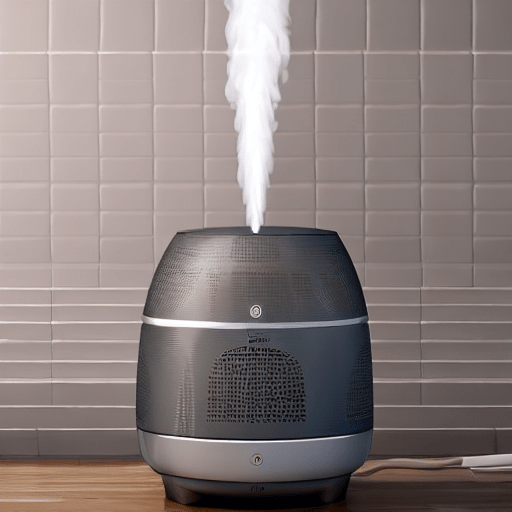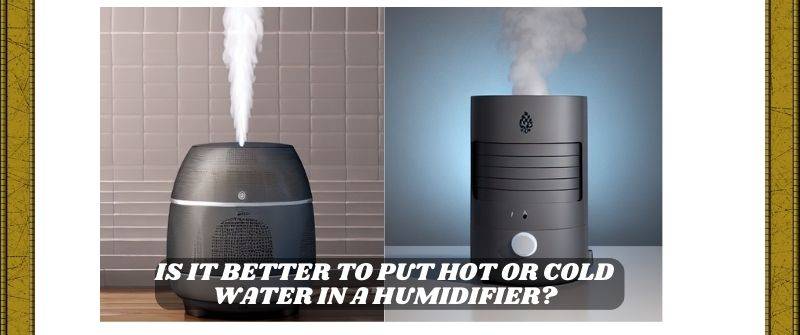There are many different styles, types, and colors of humidifiers. They are, however, divided into categories such as warm mist and cold mist. Some allow you to choose between a hot or cold mist setting, while others chill the steam being released by misting it with cold water.
Warm Mist Humidifiers

How they work:
These humidifiers have a basin or tank where water is heated by a heating element, causing it to evaporate releasing moisture into the air. It usually does this by spraying water into a fine mist with a system that may involve impellers, ultrasonic waves, and many more.
These humidifiers are labeled warm mist humidifiers because the device heats the water slightly and expels it as a mist, which then circulates with a fan to humidify the air.
The moisture they produce feels warm and they tend to raise the temperature of the area they are used.
Pros:
- In addition to humidifying the room, warm mist humidifiers also heat the room, making them very useful during cold weather or seasons. Boiling the water in the tank or basin kills any bacteria that could be present.
- Moreover, many of these humidifiers come with a special cup where liquid inhalable medication, oils, or other additives, such as essential oils or menthol rubs can be placed and dispersed in the air when the device is turned on.
Cons:
- The hot moisture released could burn small children who get too close to it.
- There is the risk of fire if the water in the basin runs out and the device is still connected to the socket. However, nowadays, the majority of warm mist humidifiers have a system that turns them off automatically when the water level is too low.
- The heating element uses more electricity than cold mist humidifiers, which is another drawback.
Cold Mist Humidifiers

How they work:
As the name implies, the cool mist is released by cool mist humidifiers. It works when a wick and a motorized filter draw water from the humidifier’s tank up to a pressure chamber. Water droplets are broken down and then released as a misty spray.
Pros:
- They are normally less expensive to purchase and operate than warm humidifiers because they lack a heating element, which consumes a lot of electricity.
- Young children and babies can use them safely because no hot steam is released which could cause a burn hazard.
- For humidifying larger spaces, cold mist humidifiers are a preferable choice.
Cons:
- Cold mist humidifiers don’t raise a room’s temperature since the mist they produce is cool rather than warm, and they may not make a significant contribution to heating during cold weather.
- As the water in the tank or basin is not boiled, it can quickly grow bacterial and viral growth if it is not changed frequently.
Is it Better to Put Hot or Cold Water in A Humidifier?
It is difficult to determine whether hot or cold water is preferable when using a humidifier because either can be used.
Ultimately, the answer to this question will depend on whether or not you intend to add medicines or supplements to the water tank and if so, where you intend to add them.
It would probably be best to simply stick with the water source that comes with the humidifier (or ask for clarification) if they don’t list either hot or cold water as appropriate, if so, then it could be safer to simply use the water source that comes with the humidifier.
You may also want to consider checking the manual before you fill the water tank–the best way to ensure you get the information you need is to read the instructions provided in the manual.
Warm Mist Humidifiers vs Cold Mist Humidifiers
Cold mist humidifiers run at 41 degrees or below and warm mist humidifiers remain between 42 degrees and 110 degrees. If you’re unsure which humidifier is better. Both warm mist and cold mist humidifiers have a lot of advantages for you.
When the weather is too chilly, warm mist humidifiers are frequently employed. This humidifier is thought to have a lower danger of bacterial growth because it has heating capabilities.
Warm mist humidifiers can improve comfort levels in a house and help with a variety of ailments and symptoms.
Those who experience symptoms of asthma, dry skin, or dust allergies can benefit from this gadget. Infections of the nose, throat, mouth and nasal passages include the common cold, flu, strep throat, and sinus infections.
Additionally, the moisture that this device emits might help your house stay warm.
It’s a nice fact that you can now buy humidifiers that have nightlights built in to help you go to sleep.
Nonetheless, proper use practices of warm mist humidifiers at home call for keeping the device out of the reach of children and pets to prevent any unintentional water spills or element burns.
On the other side, when it’s too hot out, people frequently use cool mist humidifiers. It operates by releasing water droplets at ambient temperature into the room atmosphere.
There are three types of cool mist humidifiers: impeller, evaporative, and ultrasonic.
Cool mist using ultrasound Humidifiers employ ultrasonic vibrations to create a cool mist; evaporative humidifiers use a fan to circulate air through a substance that absorbs moisture, and impeller humidifiers use a rotating disk to create water droplets that are then circulated into the air.
If not maintained properly, the usage of a water-absorbent wick filter can get unclean; bacteria can be blown into the air and potentially exacerbate your cold or flu.
Additionally, a cold mist humidifier works better to reduce pain and swelling in the nose and throat.
A cold mist humidifier is a preferable choice because it is safer in a house with small children and babies.
The bottom line is that both humidifiers are good. Therefore it is up to you to decide which of these humidifiers is more suited to the area you want to hydrate.
What is the difference between humidifiers and vaporizers?
Both humidifiers and vaporizers deal with the problem of low humidity and colds. Find out if one is really superior to the other below.
A humidifier can fix very dry (low humidity) air to make it more comfortable to breathe. The humidifiers do this by adding moisture into the air making breathing easy.
One criticism of humidifiers is how challenging it is to regulate the quantity of humidity they add to the air.
A room with excessive humidity risks having its paint and wood damaged, as well as making breathing difficult.
Mold and fungi are also drawn to humidifiers.
On the other hand, a vaporizer uses heat to accomplish the same task as a humidifier. A conventional vaporizer produces heated vapors, in contrast to the humidifier’s cold mist vapors.
In two ways, vaporizers excel over humidifiers.
The first benefit is the removal of the unpleasant moisture that a regular humidifier overproduces. Mold spread is far less likely with vaporizers.
Germs are something else they eliminate.
By boiling the water, the vast majority of bacteria are killed, and they never cant come anywhere near the vaporizer.
The humidifier has the potential to disperse microorganisms that have colonized its medium into the room.
Traditional vaporizers have the drawback of frequently being extremely hot.
They are therefore hazardous to children, animals, and people who are unaware of the presence of a hot vaporizer.
In general, all types of humidifiers serve the same purpose, which is to add moisture to the air.
They are both effective for treating colds and other upper respiratory conditions. So, It depends on your preferences which one you choose. Both of these offer benefits and drawbacks that you may have to work around.
Here is another post for Dehumidifier For the Bathroom
Conclusion
In the end, using a particular humidifier comes down to personal preference. Keep in mind that either warm water or cold water can be utilized with both types of humidifiers. However, it’s important to perform a study before buying a humidifier so that you can choose the model that will work best for your particular needs.
The hot mist humidifier is typically recommended since it produces more vapor than the cold one and prevents the formation of bacteria. Overall, picking this option will probably make you happy with your choice. Since the warm mist is a little calming and feels good inside the room, many people also appreciate it.
- 25 Easy Crafts to Make and Sell Fast for Profit at Home - June 21, 2025
- 16 Essential Fall Maintenance Tasks to Prep Your Home for Winter - June 17, 2025
- Summer Home Prep: What to Fix and Clean Before the Heat Hits - June 14, 2025

